| Shinmiyagawa Dam | |
|---|---|
 | |
| Location | Fukushima Prefecture, Japan. |
| Dam and spillways | |
| Impounds | Agano River |
Shinmiyagawa Dam is a dam in the Fukushima Prefecture of Japan, completed in 2004. [1]
| Shinmiyagawa Dam | |
|---|---|
 | |
| Location | Fukushima Prefecture, Japan. |
| Dam and spillways | |
| Impounds | Agano River |
Shinmiyagawa Dam is a dam in the Fukushima Prefecture of Japan, completed in 2004. [1]
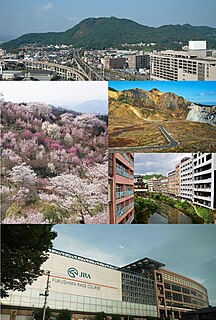
Fukushima is the capital city of Fukushima Prefecture, Japan. It is located in the northern part of the Nakadōri, central region of the prefecture. As of 1 May 2021, the city has an estimated population of 283,742 in 122,130 households and a population density of 370 inhabitants per square kilometre (960/sq mi). The total area of the city is 767.72 square kilometres (296.42 sq mi).

Sukagawa is a city located in Fukushima Prefecture, Japan. As of 1 May 2018, the city had an estimated population of 76,251 in 38824 households, and a population density of 270 persons per km2. The total area of the city was 279.43 square kilometres (107.9 sq mi).

Ten-ei is a village located in Fukushima Prefecture, Japan. As of 1 January 2020, the village had an estimated population of 5,258 in 1717 households, and a population density of 23 persons per km². The total area of the village was 225.52 square kilometres (87.07 sq mi).
Shimogō is a town located in Fukushima Prefecture, Japan. As of 1 April 2020, the town had an estimated population of 5,517 in 2216 households and a population density of 17 persons per km2. The total area of the town was 317.04 square kilometres (122.41 sq mi).

Hinoemata is a village located in Fukushima Prefecture, Japan. As of 1 January 2020, the village had an estimated population of 556, and a population density of 1.5 persons per km². The total area of the village was 390.46 square kilometres (150.76 sq mi). It is locally famous for its soba and known nationally for its kabuki performances and as a gateway to the Oze marshlands.

Tadami is a town located in Fukushima Prefecture, Japan. As of 1 March 2020, the town has an estimated population of 4,117 in 1749 households, of which 45.88% were classified as "elderly households" The town had a population density of 5.5 persons per km2. The total area of the town was 747.56 square kilometres (288.63 sq mi). Tadami is famous locally for its own Snow Festival, where huge sculptures and replicas of monuments are cut out of Tadami's abundant snow.
Mishima is a town located in Fukushima Prefecture, Japan. As of 1 March 2020, the town had an estimated population of 1,590 in 755 households, and a population density of 18 persons per km². The total area of the town was 90.81 square kilometres (35.06 sq mi). In 2017, Mishima was selected as one of The Most Beautiful Villages in Japan.

Nishigō is a village located in Fukushima Prefecture, Japan. As of 1 March 2020, the village had an estimated population of 20,351 in 7618 households and a population density of 110 persons per km2. The total area of the village was 192.06 square kilometres (74.15 sq mi)..

Miharu is a town located in Fukushima Prefecture, Japan. As of 1 March 2020, the town had an estimated population of 17,471 in 6348 households, and a population density of 240 persons per km². The total area of the town was 72.76 square kilometres (28.09 sq mi).
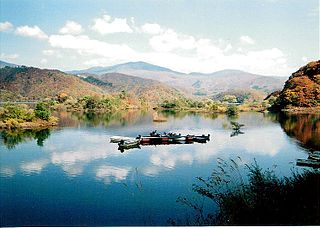
Akimoto Lake (秋元湖) is a lake that is technically classified as a reservoir. It straddles the border of the village of Kitashiobara and the town of Inawashiro, both in the Yama district of Fukushima Prefecture, Japan. Along with Hibara Lake and Onogawa Lake, it forms what is known as the "Inner Bandai Plateau Tri-Lake Formation".

Asahi Dam (旭ダム) is a dam in Shimogō, Fukushima Prefecture, Japan, completed in 1935.
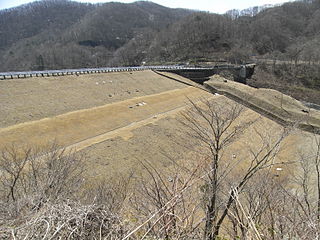
Hatori Dam is a dam in Ten'ei, Fukushima Prefecture, Japan. Hatori Dam is managed directly by the Ministry of Agriculture, Forestry and Fisheries, and is intended to provide irrigation for the Shirakawa area of the Abukuma River Basin. The dam is an earth dam with a height of 37.1 meters. The reservoir created by the dam is called Lake Hatori, and has been developed as a resort area.

Honna Dam is a gravity dam on the Tadami River in Kaneyama, Fukushima Prefecture, Japan. It was constructed between 1952 and 1954 for the purpose of hydroelectric power generation. It supplies a 78 MW power station with water.

Kaminojiri Dam is a dam in Nishiaizu, Fukushima Prefecture, Japan, completed in 1958.

Yamasato Dam is a dam in the Fukushima Prefecture of Japan, completed in 1943.

Miharu Dam (三春ダム) is a concrete gravity dam on the Ōtakine River, a branch of the Abukuma River in the town of Miharu, Fukushima in the Tōhoku region of Japan. The dam was completed in 1997.
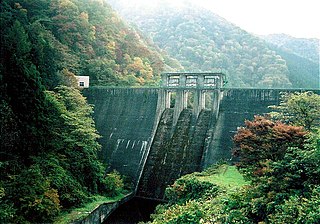
Miyagawa Dam is a dam in the Fukushima Prefecture of Japan, completed in 1962.

Surikamigawa Dam (摺上川ダム) is a rock-fill dam built on the Surikami River in the Moniwa area of Iizaka, Fukushima, Fukushima Prefecture, Japan. It was opened in 2006 and is administered by the Tohoku Regional Bureau Ministry of Land, Infrastructure and Transport.

Aizumisato is a town located in Fukushima Prefecture, Japan. As of 1 March 2020, the town had an estimated population of 20,092 in 7306 households and a population density of 73 persons per km2. The total area of the town was 276.33 square kilometres (106.69 sq mi).
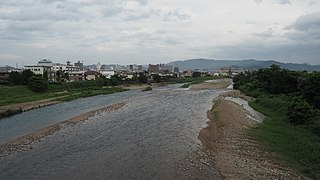
The Arakawa River is a river in Fukushima, Fukushima, Japan.
| Wikimedia Commons has media related to Shin-Miyakawa Dam . |